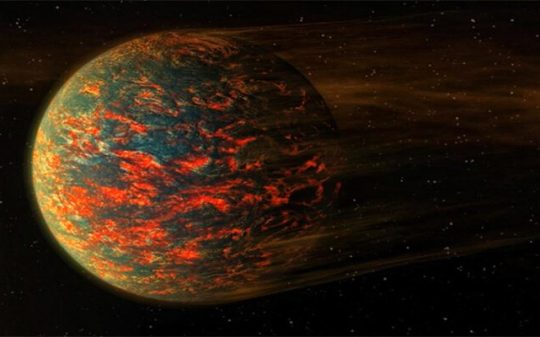Using the combined power of an array of telescopes from different locations across the globe, ESO astronomers managed to capture the first clear image of an exoplanet located in a star system 11 quadrillion kilometers away from Earth.
Astronomers’ pursuit in finding exoplanets (new planets orbiting other stars) is realized with various methods. One method is direct imaging, which has proved to be successful so far, being effective especially for planets on wide orbits around young stars, because the light reflected from the planet is not eclipsed by light reflected from the host star, making it easier to spot the needle in the haystack.
The captured image confirms the efficiency of this technique, showing a T-Tauri star named CVSO 30, situated about 1200 light-years away from Earth, northwest of Orions Belt, in the 25 Orionis cluster.
CSVO 30 is believed to host one exoplanet called CVSO 30b, as of its discovery in 2012, by the means of transit photometry, a detection method which seeks the light from a star visibly dipping plummeting as a planet heads in front of it.
For the moment, astronomers observe the system with a number of telescopes, combining every piece of information acquired with ESO’s VLT (Very Large Telescope) in Chile, with the data collected from the W.M. Keck Observatory in Hawaii, and finally with data gathered from the Calar Alto Observatory facilities in Spain.
Using the centralized data from the three observational facilities, the astronomers now have a better and more defined point of view on what seems to be a second planet. To generate the image, astronomers made use of the astrometry provided by VLT’s NACO and SINFONI instruments.
This new exoplanet entitled as CVSO 30c, is the small dot to the upper left of the frame, the massive blot being the star itself. While CVSO 30b orbits noticeably close to the star, revolving around CVSO 30 in less than 11 hours with an orbital distance of 0.008 au, CVSO 30c orbits considerably further away, at a distance of 660 au, requiring a mind-boggling 27,000 years to execute a single orbit. (For reference, the planet Mercury orbits the Sun at an average distance of 0.39 au, while Neptune sits at just over 30 au.)
“If it is confirmed that CVSO 30c orbits CVSO 30, this would be the first star system to host both a close-in exoplanet detected by the transit method and a far-out exoplanet detected by direct imaging,” ESO representatives wrote in a description of the new image.
“Astronomers are still exploring how such an exotic system came to form in such a short timeframe, as the star is only 2.5 million years old; it is possible that the two planets interacted at some point in the past, scattering off one another and settling in their current extreme orbits,” they added.
In a premiere event, ESO has imaged without prevarication a planet around its host star. Humans are now capable to directly render imagery of exoplanets, an achievement long targeted since the discovery of stellar wobbling that paved the way to the technique first used to detect planets around other stars.
With this discovery, it has become a certainty that new techniques and optics will be developed in order for us to continue the completion of the vast puzzle that is our visible and reachable universe.
Sooner that we expect, it will be possible to image satellites orbiting other planets. With an optical edge, it could also lead to the discovery of alien artifacts that now are undetectable by us. Only time will tell just how deep our knowledge and insight can become.











Trackbacks/Pingbacks